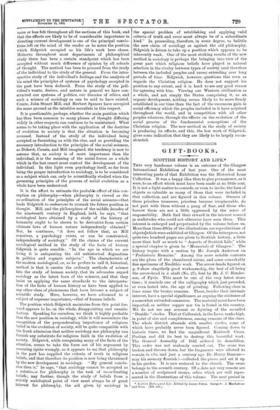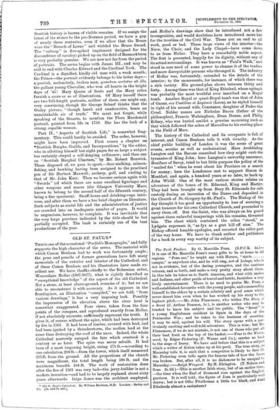GIFT-BOOKS.
SCOTTISH HISTORY AND LIFE.*
THIS very handsome volume is an outcome of the Glasgow International Exhibition of last year. One of the most interesting parts of that Exhibition was the Historical Loan Collection. It was a happy idea thus to give permanence, as it were, to an effort which must have been made at no little cost.. It is not a light matter to concede, or even to invite, the loan of objects so valuable as many of those that were included in that collection, and are figured in this volume. Owners of these priceless treasures, priceless because irreplaceable, do not part with them without a pang of fear, and those who borrow them are not a little oppressed by the sense of responsibility. Both find their reward in the interest roused in multitudes who could not otherwise have seen them. This interest is enlarged and perpetuated by the volume before us. More than three-fifths of the illustrations are reproductions of objects:which were exhibited at Glasgow. Of the letterpress, not quite two hundred pages are given to Scottish history, a little more than half as much to " Aspects of Scottish Life," while. a special chapter is given to " Memorials of Glasgow." The history begins with a section by Mr. Joseph Anderson on " Prehistoric Remains." Among the more notable contents are the plans of the chambered cairns, and some remarkably fine specimens of Neolithic work. The arrow-heads figured on p. 9 show singularly good workmanship, the best of all being the arrow-head in a shaft (No. 27), lent by Mr. J. C. Hender- son, of Fyvie. This must be one of the very latest stone. time ; it reminds one of the calligraphy which just preceded, or even lasted into, the age of printing. Following close in time come the bronze remains. These, besides their intrinsic interest, have a special significance, as arguing the existence of a somewhat extended commerce. The material must have been imported, as neither copper nor tin is found in the country. We do not see any account or figuring of the so-called " Druidic " circles. That at Callernish, in the Lews, ranks high, in point of size and completeness, among yemains of the class. The whole district abounds with smaller circles, some of which have probably never been figured. Coming down to historic times, we find the magnificent Ruthwell Cross. Puritan zeal did its best to destroy this beautiful work, The General Assembly of 1642 ordered its demolition. This order was not zealously carried out. The cross was broken and thrown down, but the fragments were allowed to remain in situ, and just a century ago Dr. Henry Duncan— may his memory flourish !—collected the pieces and set it up in his garden. It is now restored to the church. The cross belongs to the seventh century. Of a date not very remote are a number of sculptured stones, relics which are well repre- sented in the illustrations of this volume. The next period in • Scottish History and Life. Eluted by James Paton. Glasgow J. MacLehose and Sims. [42s. net.1
Scottish history is barren of visible remains. If we assign the latest of the stones to the pre-Norman period, we have a gap of nearly three centuries, even if we allow that the Brace wore the " Brooch of Lorne " and wielded the Bruce Sword. The " caltrop " (a five-spiked implement designed for the
discomfiture of cavalry) picked up on the field of Bannockbrini is very probably genuine. We are now not far from the period of portraits. The series begins with James III., and may be said to end with Charles Edward and the Cardinal York. The Cardinal is a dignified, kindly old man with a weak mouth ; the Prince—the portrait evidently belongs to his latter days— a peevish, melancholy, broken man, quantum, mutatus ab illy the gallant young Chevalier, who won all hearts in the bright days of '45! Mary Queen of Scots and the Mary relics furnish a score or so of illustrations. Of Mary herself there are two full-length portraits, neither of them, one might say, very convincing, though Sir George Scharf thinks that the Oudry picture, " though harsh and unattractive, bears an unmistakable air of truth." We must not forget, while speaking of the Stuarts, to mention the Flora Macdonald portrait, painted from life in 1750. She has the look of a strong, capable woman.
Part II., " Aspects of Scottish Life," is somewhat frag- mentary. This could hardly be avoided. The order, however, might have been improved. First comes a chapter - on "Scottish Burghs, Guilds, and Incorporations," by the editor, who in allotting himself but eight pages for so large a subject has certainly obeyed a self-denying ordinance ; and then one on " Scottish Burghal Charters," -by Mr. Robert Renwick. These disposed of, we pass to sport,—deer-stalking, salmon- fishing, and hawking having been assigned to the practised pen of Sir Herbert Maxwell; archery, golf, and curling to that of Mr. John Kerr. Then we become serious again with " Swords " (of which there are some excellent figurings) and other weapons and maces (the Glasgow University Mace, known to belong to the second half of the fifteenth century, being a fine specimen). Snuff-boxes and drinking-cups inter- vene, and after them we have a too brief chapter on literature. Such subjects as social life and the administration of justice are crowded into an inadequate number of pages. It would be ungracious, however, to complain. It was inevitable that the very large province indicated by the title should be but partially occupied. The book is certainly one of the best productions of the year.























































 Previous page
Previous page